If we can organize the Southern States for massive resistance to this order, I think that in time the rest of the country will realize that racial integration is not going to be accepted in the South.
Harry Byrd, United States Senator from Virginia, February 1956 86 Newport News (Va.) Daily Press, “Byrd Calls for ‘Massive’ Resistance to Integration,” February 26, 1956.
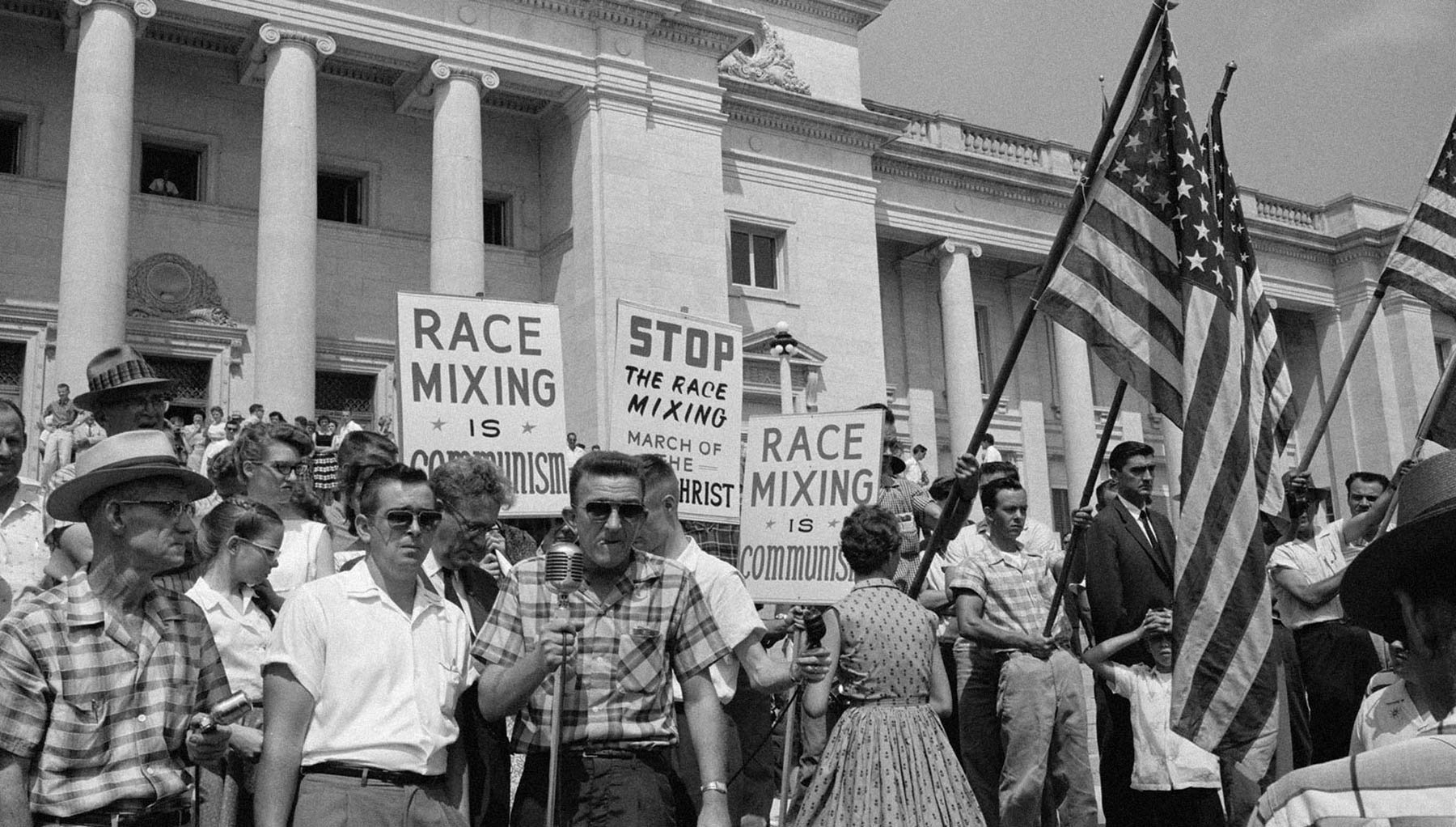
Crowd protests the admission of Black students to Central High School in Little Rock, Arkansas, 1959. (John T Bledsoe/PhotoQuest/Getty Images)
The Supreme Court was a reliable partner in maintaining slavery and in the campaign to rebuild and strengthen racial hierarchy and white supremacy after the Civil War. When the Court changed course in the mid-20th century and began striking down laws that authorized racial discrimination and segregation, many white people in the South felt betrayed.
On May 17, 1954, in Brown v. Board of Education of Topeka, the Supreme Court unanimously invalidated racial segregation in public education, reasoning that segregated public schools were “inherently unequal” and violated the Equal Protection Clause of the Fourteenth Amendment. 87 Brown v. Board of Education Topeka, 347 U.S. 483, 495 (1954). By overturning the nearly 60-year-old precedent of “separate but equal,” 88 Plessy v. Ferguson, 163 U.S. 537 (1896). Brown threatened to dislodge a cornerstone of the Southern racial caste system.
Brown outraged white segregationists as much as it energized civil rights activists. Throughout the South, where state constitutions 89 Miss. Const. Art. 8, Sec. 207 (1890) (“Separate schools shall be maintained for the children of the white and colored races.”). and state law 90 Miss. Code § 6276 (1942). mandated segregated schools, white people decried the decision as a tyrannical exercise of federal power. Within months, Brookhaven, Mississippi, circuit judge Thomas Pickens Brady published a pamphlet that predicted Brown would harm both races.91 Tom P. Brady, Black Monday (Winona: Association of Citizens’ Councils of Mississippi, 1954), 3.
What the Supreme Court needs to do is to spend about thirty days in Georgia, Alabama, Louisiana, Mississippi or East Texas and associate intimately with the average Negro family. It should do this in August, mind you, and then the Supreme Court would have a passing understanding of the Negro and his problems, and its decision would not embody within it such foolishness as “many Negroes have achieved outstanding success in the arts and sciences, as well as in the business and professional world.” . . .
In so far as the South is concerned, the Southern Negro knows we are his friend. We have provided his material necessities when he could not do so for himself. Gradually we have opened the door of opportunity to him and will continue to do so. The South has produced some Negroes of considerable wealth and ability. Doctors, lawyers, educators, ministers, businessmen and farmers can be found among them, but “one swallow does not make a summer.” 92 Ibid., 3-4.
 Fort Lauderdale, Florida, 1964. (Steve Schapiro)
White Americans implemented a strategy of “massive resistance” to desegregation by deploying a range of tactics and weapons against the growing movement for civil rights. Some of these tools, such as bombing and murdering civil rights activists, continued
the tradition of maintaining white supremacy through lethal violence. Other methods, such as criminalizing, arresting, and imprisoning peaceful protestors, foreshadowed the modern mass incarceration era.
Fort Lauderdale, Florida, 1964. (Steve Schapiro)
White Americans implemented a strategy of “massive resistance” to desegregation by deploying a range of tactics and weapons against the growing movement for civil rights. Some of these tools, such as bombing and murdering civil rights activists, continued
the tradition of maintaining white supremacy through lethal violence. Other methods, such as criminalizing, arresting, and imprisoning peaceful protestors, foreshadowed the modern mass incarceration era.
Opposition to civil rights and racial equality was a mass movement. Most white Americans, especially in the South, supported segregation.
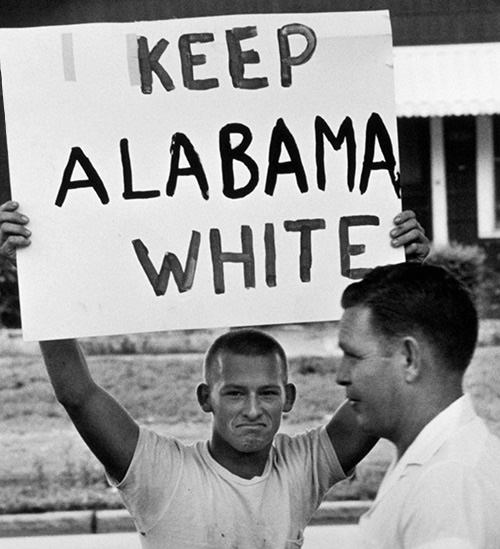 A young man protests school desegregation in Montgomery, Alabama, in 1963. (© Flip Schulke)
Only a small minority of white Americans actively dissented from the widespread opposition to civil rights by engaging in civil rights activism and supporting Black activists.
A young man protests school desegregation in Montgomery, Alabama, in 1963. (© Flip Schulke)
Only a small minority of white Americans actively dissented from the widespread opposition to civil rights by engaging in civil rights activism and supporting Black activists.
More than ever before, white people used their opposition to civil rights to prove their Southern loyalty and measure that of their neighbors. “Not unlike pro-slavery zealots of the 1850s,” historian Neil McMillen observed, “the pro-segregationists
of a century later were inclined to brook no latter-day abolitionism among fellow southerners. . . . In this repressive atmosphere the moderate was vilified and he who was found ‘soft’ on integration was adjudged treasonous.”
93
Neil McMillen, The Citizens’ Council: Organized Resistance to the
Second Reconstruction, 1954-1964 (Champaign: University of Illinois
Press, 1994), 235.
With battle lines drawn, whiteness now required action.
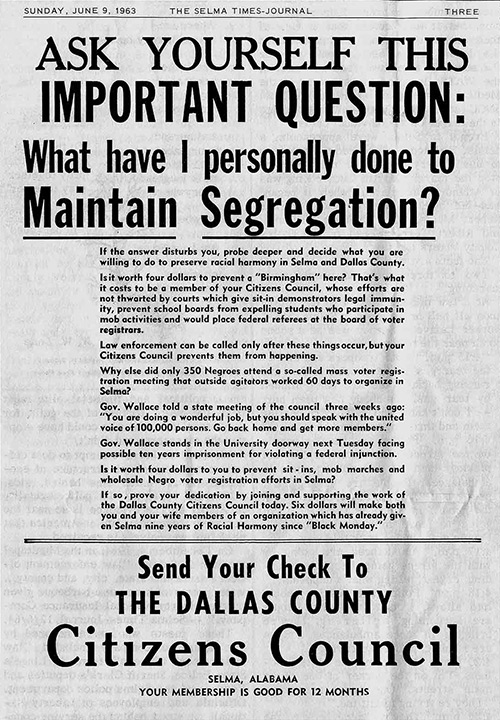 A White Citizens’ Council’s recruiting pamphlet published in
the Selma Times Journal on June 9, 1963. (Student Nonviolent
Coordinating Committee, courtesy of Wisconsin Historical
Society)
116
George Lewis, Massive Resistance: The White Response to the Civil
Rights Movement (New York: Bloomsbury Academic, 2006), 40.
were working together to delay school desegregation through political action, economic intimidation, and even violence.
White Citizens’ Councils spread rapidly throughout the South. Within two years, more than 250,000 determined members
116
Brown v. Bd. of Educ. of Topeka, 347 U.S. 483, 495 (1954).
were working together to delay school desegregation through political action, economic intimidation, and even violence.
A White Citizens’ Council’s recruiting pamphlet published in
the Selma Times Journal on June 9, 1963. (Student Nonviolent
Coordinating Committee, courtesy of Wisconsin Historical
Society)
116
George Lewis, Massive Resistance: The White Response to the Civil
Rights Movement (New York: Bloomsbury Academic, 2006), 40.
were working together to delay school desegregation through political action, economic intimidation, and even violence.
White Citizens’ Councils spread rapidly throughout the South. Within two years, more than 250,000 determined members
116
Brown v. Bd. of Educ. of Topeka, 347 U.S. 483, 495 (1954).
were working together to delay school desegregation through political action, economic intimidation, and even violence.
In South Carolina, the councils had 55 chapters totaling 40,000 members by July 1956.
117
Ibid.
Within two weeks after 17 Black parents signed a pro-integration petition in the community of Elloree, South Carolina, all had lost their jobs or been evicted from their farms; 14 of the parents asked to withdraw their names.
118
Ibid.
Mississippi had 60,000 members by October 1955. When 53 Black residents of Yazoo County signed a desegregation petition launched by the NAACP, the council published a newspaper ad naming them and they faced widespread harassment, lost
work, and even had their bank accounts cancelled. Ultimately, all signers removed their names and the Yazoo County NAACP was disbanded.
119
Kate Ellis and Stephen Smith, “The Citizens’ Council,” State of
Siege: Mississippi Whites and the Civil Rights Movement (American
Radio Works, 2014), http://americanradioworks.publicradio.org/
features/mississippi/c1.html.
The National Association for the Advancement of Colored People, formed in 1909 as a bi-racial organization to advance justice for African Americans, faced retaliation from segregationists long before the civil rights era. But its role in Brown made the NAACP a target of white politicians, lawmakers, and angry community members
120
Lewis, Massive Resistance, 90. A membership card issued in late 1955
by one Alabama Citizens’ Council pledged “to help defeat the NAACP;
Integration, Mongrelism, Socialism, Communist ideologies, FEPC and
One World Government.”
who blamed it for the crisis of desegregation and declared war on its members.
121
Klarman, From Jim Crow to Civil Rights, 351-52.
White Citizens’ Councils throughout the South capitalized on whites’ dominance over financial capital, land ownership, and industry to punish civil rights participation. After the local council circulated the roster of NAACP members
in Clarendon County, South Carolina, those listed promptly lost their jobs, credit, and suppliers.
Z. Alexander Looby and Arthur Shores, Black NAACP lawyers who actively filed desegregation lawsuits after Brown, both survived bombings of their homes in the early 1960s.
122
Ibid.
But other bombings claimed the lives of NAACP activists, including Harry and Harriette Moore, teachers and founders of the NAACP chapter in Brevard County, Florida. Their deaths in an explosion at their home on Christmas Day in 1951 led
to protests across the nation but no immediate arrests.
123
Shreveport (La.) Times, “Faubus Advances Date for Special Ark.
School Vote,” September 17, 1958.
In Mississippi alone, the list of murdered NAACP activists included Reverend George Lee (1955), Medgar Evers (1963), Louis Allen (1964), and Vernon Dahmer (1966). “A jury would not dare convict a white man for killing a nigger in Mississippi,”
boasted Klansman Sam Bowers after he was indicted for Mr. Dahmer’s murder. He was not convicted.
124
Charles Marsh, God’s Long Summer: Stories of Faith and Civil Rights
(Princeton: Princeton University Press, 2008), 192.
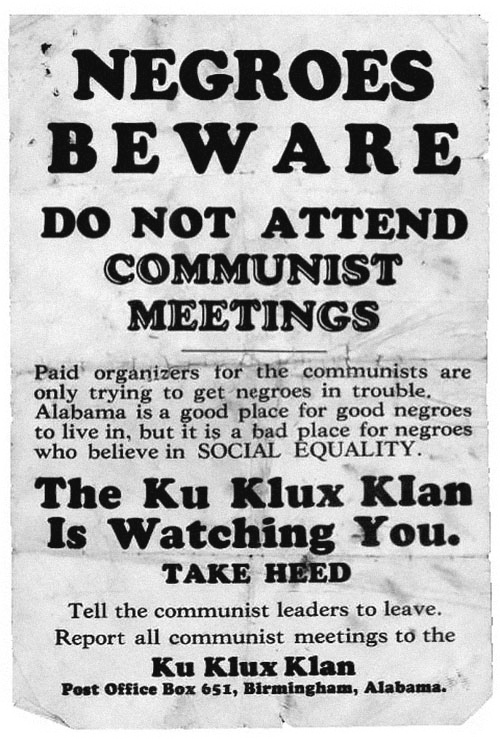 A threatening poster circulated by the KKK in Birmingham, Alabama (1933). (Alabama Department of Archives and History.)
Opponents also used legislation to undermine NAACP activities. Between 1956 and 1960, states passed some 230 laws targeting desegregation activists, and most specifically targeted the NAACP.
125
Lewis, Massive Resistance, 92.
Some laws explicitly barred NAACP members from public employment, especially as school teachers;
126
Klarman, From Jim Crow to Civil Rights, 383.
the NAACP and its members were harassed with criminal prosecutions and bar association disciplinary proceedings; and some states outlawed the organization entirely.
127
Ibid., 383; Lewis, Massive Resistance, 92
A threatening poster circulated by the KKK in Birmingham, Alabama (1933). (Alabama Department of Archives and History.)
Opponents also used legislation to undermine NAACP activities. Between 1956 and 1960, states passed some 230 laws targeting desegregation activists, and most specifically targeted the NAACP.
125
Lewis, Massive Resistance, 92.
Some laws explicitly barred NAACP members from public employment, especially as school teachers;
126
Klarman, From Jim Crow to Civil Rights, 383.
the NAACP and its members were harassed with criminal prosecutions and bar association disciplinary proceedings; and some states outlawed the organization entirely.
127
Ibid., 383; Lewis, Massive Resistance, 92
In 1956, Alabama Attorney General John Patterson filed suit to enjoin the NAACP’s activities in the state and demanded access to its membership lists and other records. “The NAACP is no credit to the Negro race and has set the Negro’s
cause back 100 years in Alabama,” remarked Patterson, who was later elected governor.
128
Tennessean, “NAACP Contempt Fine Ruling Disappoints Patterson,”
June 9, 1959.
The state court granted an injunction restraining the NAACP from operating in Alabama that lasted for several years until it was overturned by the Supreme Court.
129
NAACP v. Alabama, 357 U.S. 449 (1958).
Other states employed the same strategy.
Courts eventually invalidated most anti-NAACP statutes, but the lengthy litigation diverted already strained resources from civil rights efforts.
130
Klarman, From Jim Crow to Civil Rights, 383-84; Lewis, Massive
Resistance, 94, 96-97.
Harassment and violence also contributed to drops in participation: Southern membership fell from 128,000 in 1955 to 80,000 in 1957 and nearly 250 branches dissolved; NAACP activities briefly shut down statewide in Louisiana and Texas;
and Alabama’s NAACP ceased operations from 1956 to 1964.
131
Klarman, From Jim Crow to Civil Rights, 38384; Lewis, Massive
Resistance, 94, 96-97.
“At stake in the long run,” read an official NAACP press statement in 1958, “is the continued existence of NAACP in Alabama and in other Southern states which have taken similar action to ban NAACP in the belief that the civil rights
movement and desegregation of public schools can be halted if NAACP is suppressed.”
132
Tampa (Fla.) Times, “High Court Throws Out NAACP Fine,” June
30, 1958.
The language of the Court’s unanimous decision in Brown was groundbreaking, but building a nine-justice majority had cost the ruling its teeth. Just a year later, the Court in Brown II walked back its commitment to equal rights and rejected calls for immediate, federally-enforced desegregation.
Before Brown II was decided, South Carolina, Georgia, and Mississippi adopted constitutional amendments authorizing their legislatures to end public education if the Court ordered immediate desegregation. 133 Klarman, From Jim Crow to Civil Rights, 314-15 Other strategists developed policies disguised as desegregation plans that instead stopped desegregation in its tracks.
In March 1955, North Carolina became the first state to pass a pupil placement law. 134 Ralph Lee Smith, “The South’s Pupil Placement Laws: Newest Weapon Against Integration,” Commentary Magazine, October 1, 1960. Marian Wright Edelman, then a young Black civil rights lawyer named Marian A. Wright, called the policy “legalistic horseplay to keep Negro children out of white schools.” 135 Ibid. By authorizing local school districts to assign students to schools based on a long list of subjective, “race-neutral” criteria, the law maintained nearly all-white schools without explicit legal segregation. 136 Ibid. In the words of historian Earl Black, the “North Carolina Way” ended “school desegregation at a seemly pace, one approximating the crawl of an arthritic turtle.” 137 Earl Black, “North Carolina Governors and Racial Segregation,” in Politics and Policy in North Carolina, eds. Thad L. Beyle and Merle Black (MSS Information Corp., 1975), 73.
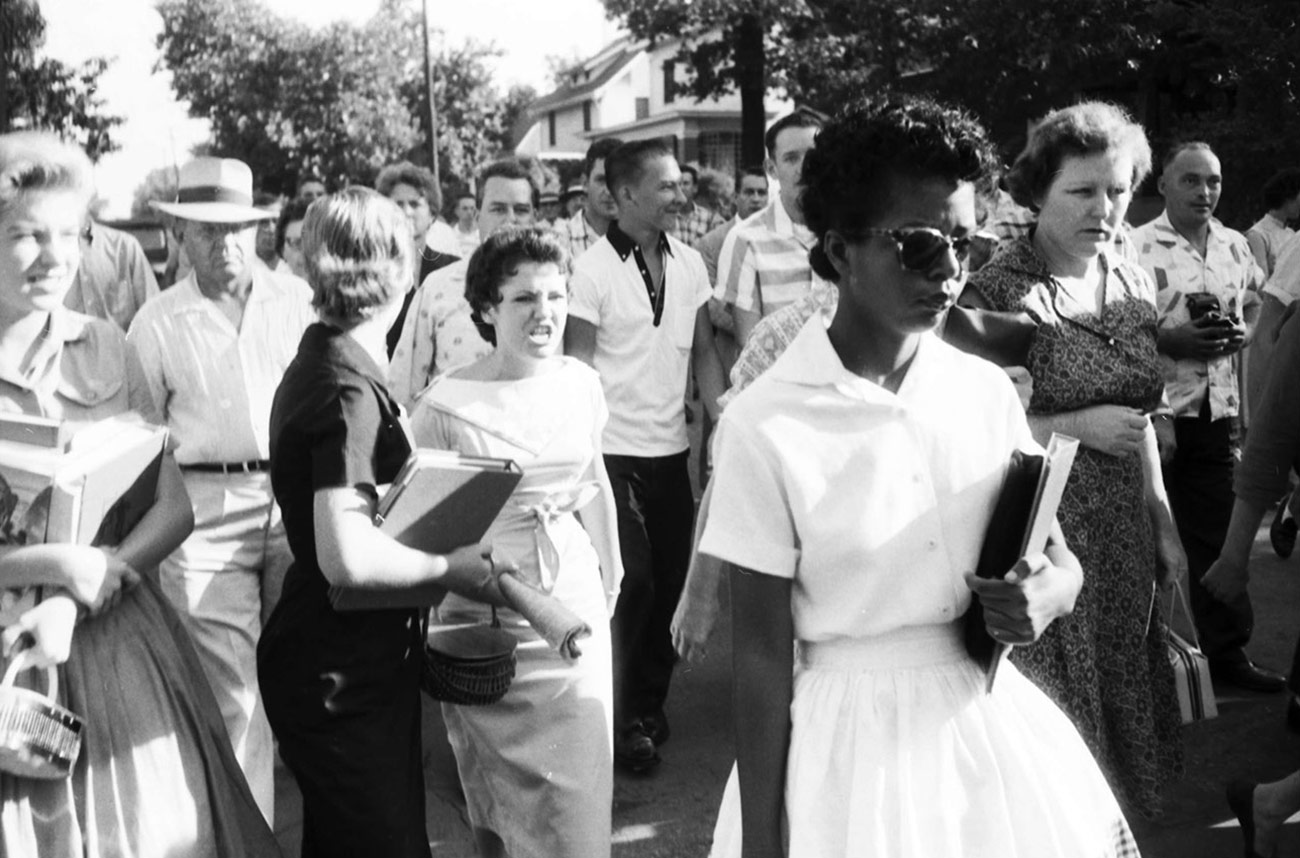
Segregationist protestors surround Elizabeth Eckford, one of nine Black students to integrate Central High School in Little Rock, Arkansas, 1957. Reflecting on the experience decades later, Ms. Eckford observed, “True reconciliation can occur only when we honestly acknowledge our painful, but shared, past.” (Will Counts Collection: Indiana University Archives)
In May 1955, the Court issued Brown II, in which it ordered schools to integrate “with all deliberate speed.” 138 Brown v. Bd. of Educ. of Topeka (II), 349 U.S. 294, 301 (1955). The decision approved gradualism, imposed no deadlines for beginning or completing integration, issued vague guidelines, and granted Southern district judges broad discretionary oversight. Hailed as a “very definite victory for the South,” 139 Miami News, “Dixie States Split Over New Ruling on Desegregation,” June 1, 1955 the ruling pleased many pro-segregation legal and political strategists and emboldened states to undermine courts’ desegregation orders.
Louisiana voters overwhelmingly approved a constitutional amendment that allowed the state to use its police powers to keep schools segregated. 140 Lewis, Massive Resistance, 32-33. In Virginia, Prince Edward County officials stopped funding public education, 141 Klarman, From Jim Crow to Civil Rights, 314-15. and North Carolina devised a plan that permitted local communities to close public schools by popular vote if they were threatened with imminent desegregation. 142 John E. Batchelor, Race and Education in North Carolina: From Segregation to Desegregation (Baton Rouge: Louisiana State University Press, 2015), 58.
North Carolina’s pupil placement law survived legal challenge in 1957, and by 1958, every other Southern state had passed their own. 143 Klarman, From Jim Crow to Civil Rights, 330. Alabama legislators explicitly declared that the state’s placement plan was intended to block integration, but in 1958, a unanimous Supreme Court nonetheless upheld the law. 144 Ibid.; Shuttlesworth v. Birmingham Bd. of Educ. of Jefferson County, Ala., 162 F. Supp. 372 (N.D. Ala. 1958), affrmed by 79 S. Ct. 221 (1958) (per curiam). Alabama officials were “jubilant,” and Senator Russell Long of Louisiana said the decision was “the most encouraging thing for the South in some time,” as it “shows a willingness of the court to settle for token integration.” 145 Klarman, From Jim Crow to Civil Rights, 331; Alexandria (La.) Town Talk, “Sen. Long Hails High Court Ruling,” November 27, 1958.
Indeed, though Brown ruled that segregated schools harmed Black students and violated their rights as Americans, Brown II prioritized the rights and preferences of white parents by enabling delay. State legislatures passed bills to thwart desegregation through “freedom-of-choice plans, which allowed parents to choose among several schools; transfer options, which permitted parents to move their children out of integrated schools; and grade-a-year plans, which started desegregation in the first or twelfth grade and then expanded it to one additional grade every year.” 146 Klarman, From Jim Crow to Civil Rights, 318.
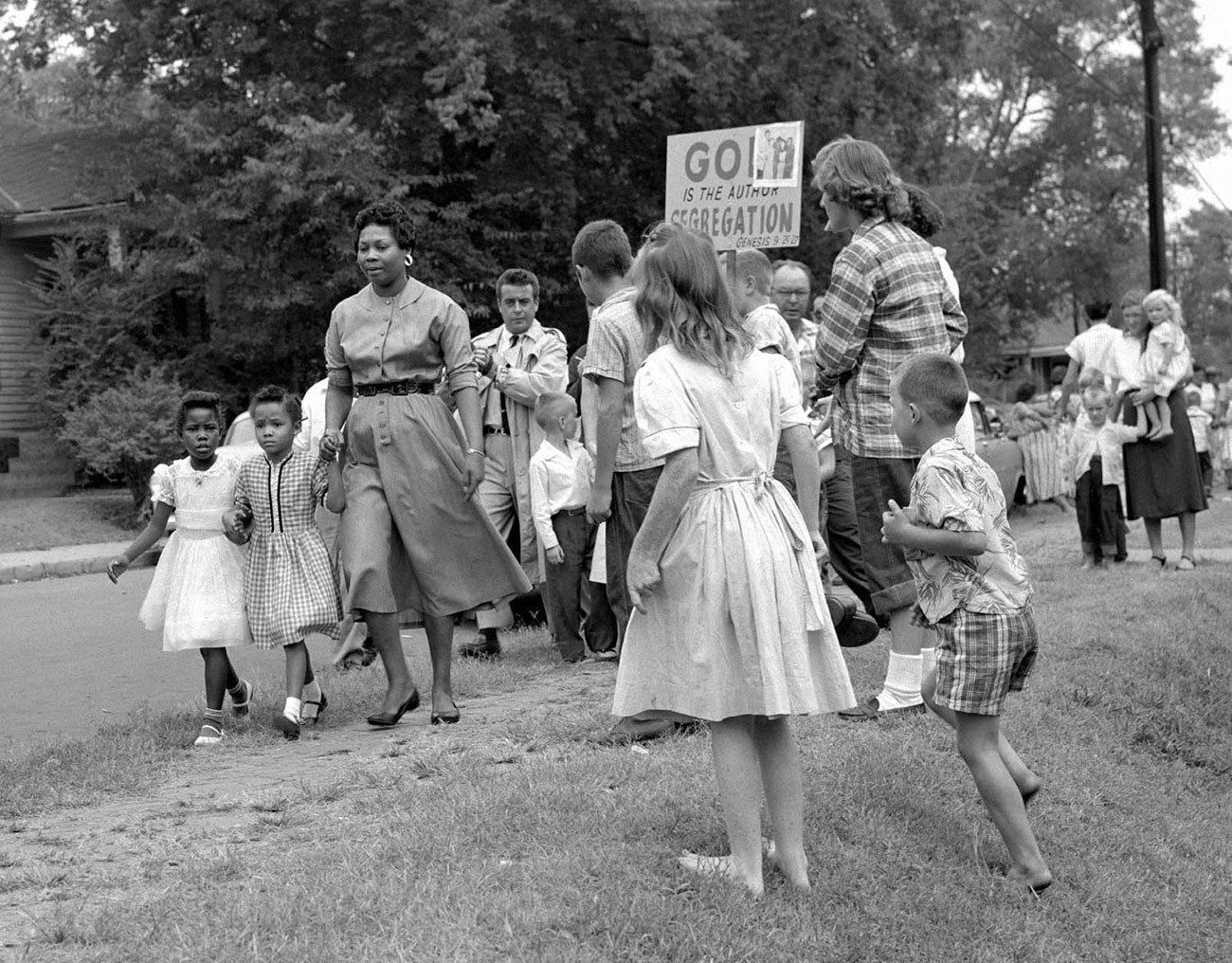
Grace McKinley walks her daughter and a friend through an angry crowd on the way to Fehr Elementary School in Nashville, Tennessee, on September 9, 1957. One member of the crowd holds a sign that reads, “God is the author of segregation.” (Nashville Public Library, Special Collections)
Strom Thurmond, former South Carolina Governor and Dixiecrat presidential candidate, was elected to the Senate in 1954 and helped draft the document. The legislatures of eight Southern states — Alabama, Arkansas, Florida, Georgia, Louisiana, Mississippi, South Carolina, and Virginia — also enacted “interposition” resolutions that denounced Brown as an “illegal encroachment” on state’s rights and declared it “null, void and of no effect.” 148 Klarman, From Jim Crow to Civil Rights, 320; Kingsport (Tenn.) Times-News, “Racial Crisis Is NOW In ‘Heart of Dixie,’” March 4, 1956.
Virtually no desegregation occurred in any states of the former Confederacy until 1957, leading one Black congressman to concede that the South had won “the first round in the battle for compliance” with Brown. 149 Klarman, From Jim Crow to Civil Rights, 348; Jackson (Miss.) ClarionLedger, “Ballot Is Negroes’ Objective–Diggs,” May 20, 1957. One exception was Clinton, Tennessee, where the integration of a small-town high school in 1956 led to prolonged violence by enraged white mobs organized by White Citizens’ Councils.
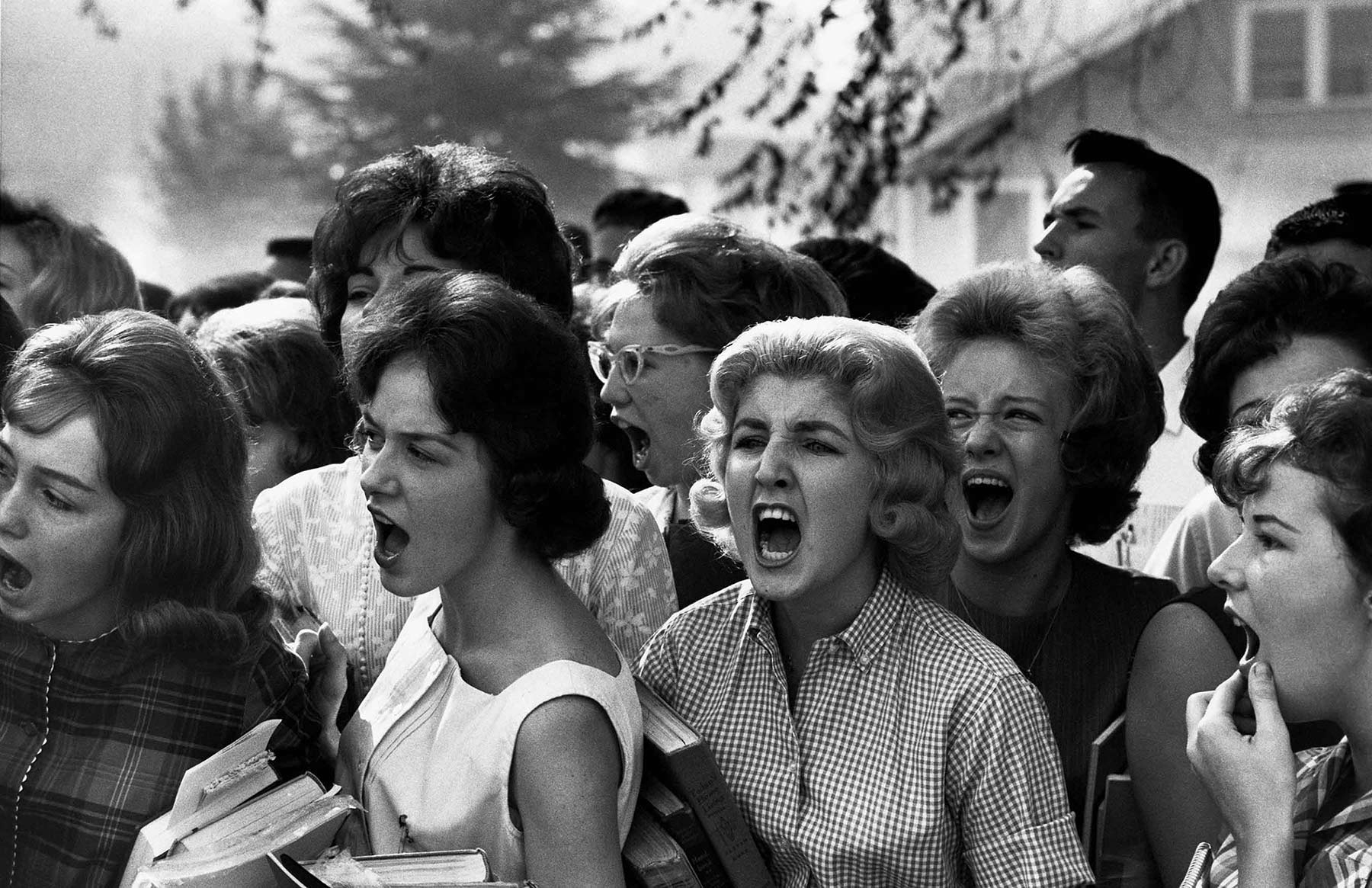
A group of teenage girls scream obscenities at Black students entering their high school in Montgomery, Alabama. (© Flip Schulke/CORBIS/ Corbis via Getty Images)
After Brown, a federal judge ordered the local high school in Clinton, Tennessee, to integrate by the start of the 1956-57 school year, and a small group of Black students dubbed the “Clinton Twelve” registered to attend class with 800 white students. 150 Bobby L. Lovett, The Civil Rights Movement in Tennessee: A Narrative History (Knoxville: University of Tennessee Press, 2005), 31-32, 43-44. John Kasper of the Seaboard White Citizens’ Council quickly arrived in Clinton, where he urged white students to boycott classes and community members to protest integration. 151 New York Times, “Integration Foe Jailed; Held for Urging Pupils to Stay Home from School,” August 27, 1956. A few days after students began classes, the crowd of pro-segregation protestors had grown to between 500 and 1000 people and the local sheriff sent the Black students home “for their own safety.” 152 New York Times, “11 Negroes Taken Out of Classes: Sheriff Says He Feared for Safety During Clashes in Tennessee ‘Mixed’ School,” August 30, 1956; Chicago Daily Tribune, “Move Negroes From School an Hour Early: For Own Safety, Says Tennessee Sheriff,” August 30, 1956.
That evening, Kasper led 800 people in an anti-integration rally on the lawn of the Anderson County courthouse. The next day, more than 200 white students boycotted class and the mob outside the school grew increasingly violent, assaulting a Black woman as she passed on the street and breaking a window at the local police station. 153 Chicago Daily Tribune, “Alert Troops in Tennessee School Clash: Negroes Stoned by Mob of 200,” August 31, 1956; Christian Science Monitor, “Anti-Integration Violence Breaks Out in Tennessee,” August 30, 1956. “We need all the rabble rousers we can get,” Kasper told a crowd of white supporters in Birmingham a few weeks later. “We want trouble and we want it everywhere we can get it — a collapse of law and order is near at hand.” 154 Columbus (Ind.) Republic, “True Segregationists: They Want Trouble and Aid of Rabble Rousers,” September 14, 1956.
Kasper was jailed for contempt of court, and Asa Carter of the North Alabama White Citizens’ Council took over leadership of the Clinton opposition. Clinton had just 4000 residents, but Carter rallied a mob of more than 1000 people for several nights, giving speeches attacking the Supreme Court and the NAACP as agents of “mongrelization” through “race mixing.” His enraged audience assaulted Black motorists and pedestrians, 155 Chicago Tribune, “Break Up School Mob, Troops Move On Tennessee Town Rioters, Force 1,500 to Quit Square,” September 3, 1956; Lubbock (Tex.) Morning Avalanche, “Guardsmen Quell Mob in Tennessee,” September 3, 1956. burned a cross on the Clinton High School lawn, and faced off with local police until, at the mayor’s request, the governor sent in the state highway patrol and national guard. 156 Chicago Daily Tribune, “Gas Routs School Mob, Vigilantes, State Police Keep Order: Governor Calls Out the Guard,” September 2, 1956; Daily Boston Globe, “Tear Gas Quells Tennessee Race Riot: Guard Unit, State Police Called Out,” September 2, 1956.
White violence escalated even after troops arrived. Segregationists shot into a home occupied by the father of one of the Clinton Twelve, threw dynamite into the Black community of a nearby town, and attempted to lynch two Black men held in the local jail. 157 Lovett, Civil Rights Movement in Tenneessee, 46-47; Philadelphia Tribune, “Whites Dynamite Negro Section: Tenn. National Guard Units Save 2 Negroes From Angry Lynch Mob,” September 11, 1956. Seventy miles away, a mob of five white men confronted two white national guardsmen near the town of Dayton and asked if they would go to Clinton to enforce integration if ordered; when one of the guardsman answered that he would, one of the men attacked him with a knife. 158 Des Moines (Iowa) Register, “Knifes Guardsman Who’d Go to Clinton ‘If Ordered,’” September 4, 1956
School resumed in Clinton after Labor Day. Troops departed and white student attendance gradually increased, but tensions remained. 159 Chicago Daily Tribune, “Peace Settles Over Riot City in Tennessee: 11 Negroes Attend School at Clinton,” September 11, 1956. On September 26, 1956, dynamite exploded in a field next to the home of one of the Clinton Twelve. 160 New York Times, “Blast Near Negro Home: Explosion Set Off at Clinton Beside Student’s House,” September 27, 1956. On December 4, a white minister who escorted the Black students to classes was beaten by enraged whites as he returned home. 161 Lovett, Civil Rights Movement in Tennessee, 47-48. On February 14, the Black section of Clinton suffered at least eight dynamite explosions and, a week later, only seven of the original Clinton Twelve remained at Clinton High School, where they experienced attacks and harassment throughout the year. 162 Ibid., 50-53. On October 5, 1958, two years after Black students first integrated Clinton High School, the school was heavily damaged in a pre-dawn bombing. 163 Louisville (Ky.) Courier-Journal, “3 Blasts Wreck Tennessee School: Integration-Linked Dynamiting at Clinton ‘Professional Job,’” October 6, 1958
In the fall of 1957, 11 Black students entered schools in three North Carolina cities and 11 entered white schools in Nashville, where an elementary school was destroyed by a dynamite explosion one day after it held integrated classes.
 In response to the admission of the Little Rock Nine, Arkansas
Governor Orval Faubus reads a statement during a segregation rally on
the steps of the State Capital in Little Rock, Arkansas. (John T Bledsoe/
PhotoQuest/Getty Images)
Nine Black students attempting to enroll at all-white Little Rock Central High School that September were confronted by angry white crowds of students and adults and blocked by Arkansas National Guard troops commanded by Governor Orval Faubus. When President
Dwight Eisenhower sent federal troops to escort the Little Rock Nine into school, hundreds of white people attacked Black residents and reporters, causing nationally publicized “chaos, bedlam, and turmoil” that led a federal court to halt desegregation.
The Supreme Court overturned that decision and ordered immediate integration, but in a move voters later approved in a referendum, Faubus closed all public high schools in Little Rock for the 1958-1959 school year.
164
Blytheville (Ark.) Courier News, “First Arrest Made in Little Rock
Crisis,” September 6, 1957; Elmira (N.Y.) Advertiser, “Ike Clears Way for
Troop Use: Bloody Assaults Block Little Rock Integration,” September
24, 1957; James L. Hicks, “Newspaperman Describes Attack Setting
Off Violence at School,” Elmira (N.Y.) Advertiser, September 24, 1957;
Cooper v. Aaron, 78 S. Ct. 1401 (1958); Sondra Gordy, Finding the
Lost Year: What Happened When Little Rock Closed its Public Schools,
(Fayetteville: University of Arkansas Press, 2009), 50-51; Klarman, From
Jim Crow to Civil Rights, 321, 326-327.
In response to the admission of the Little Rock Nine, Arkansas
Governor Orval Faubus reads a statement during a segregation rally on
the steps of the State Capital in Little Rock, Arkansas. (John T Bledsoe/
PhotoQuest/Getty Images)
Nine Black students attempting to enroll at all-white Little Rock Central High School that September were confronted by angry white crowds of students and adults and blocked by Arkansas National Guard troops commanded by Governor Orval Faubus. When President
Dwight Eisenhower sent federal troops to escort the Little Rock Nine into school, hundreds of white people attacked Black residents and reporters, causing nationally publicized “chaos, bedlam, and turmoil” that led a federal court to halt desegregation.
The Supreme Court overturned that decision and ordered immediate integration, but in a move voters later approved in a referendum, Faubus closed all public high schools in Little Rock for the 1958-1959 school year.
164
Blytheville (Ark.) Courier News, “First Arrest Made in Little Rock
Crisis,” September 6, 1957; Elmira (N.Y.) Advertiser, “Ike Clears Way for
Troop Use: Bloody Assaults Block Little Rock Integration,” September
24, 1957; James L. Hicks, “Newspaperman Describes Attack Setting
Off Violence at School,” Elmira (N.Y.) Advertiser, September 24, 1957;
Cooper v. Aaron, 78 S. Ct. 1401 (1958); Sondra Gordy, Finding the
Lost Year: What Happened When Little Rock Closed its Public Schools,
(Fayetteville: University of Arkansas Press, 2009), 50-51; Klarman, From
Jim Crow to Civil Rights, 321, 326-327.
No Southern state made any further progress toward desegregation until 1959, when Virginia admitted 21 Black students to seven previously white schools in two cities, and two formerly all-white schools in Miami, Florida, gained Black
students.
165
Klarman, From Jim Crow to Civil Rights, 349.
By the start of the 1964-65 school year, less than 3 percent of the South’s African American children attended school with white students, and in Alabama, Arkansas, Georgia, Mississippi, and South Carolina that number remained substantially below 1 percent. 167 Lewis, Massive Resistance, 114.
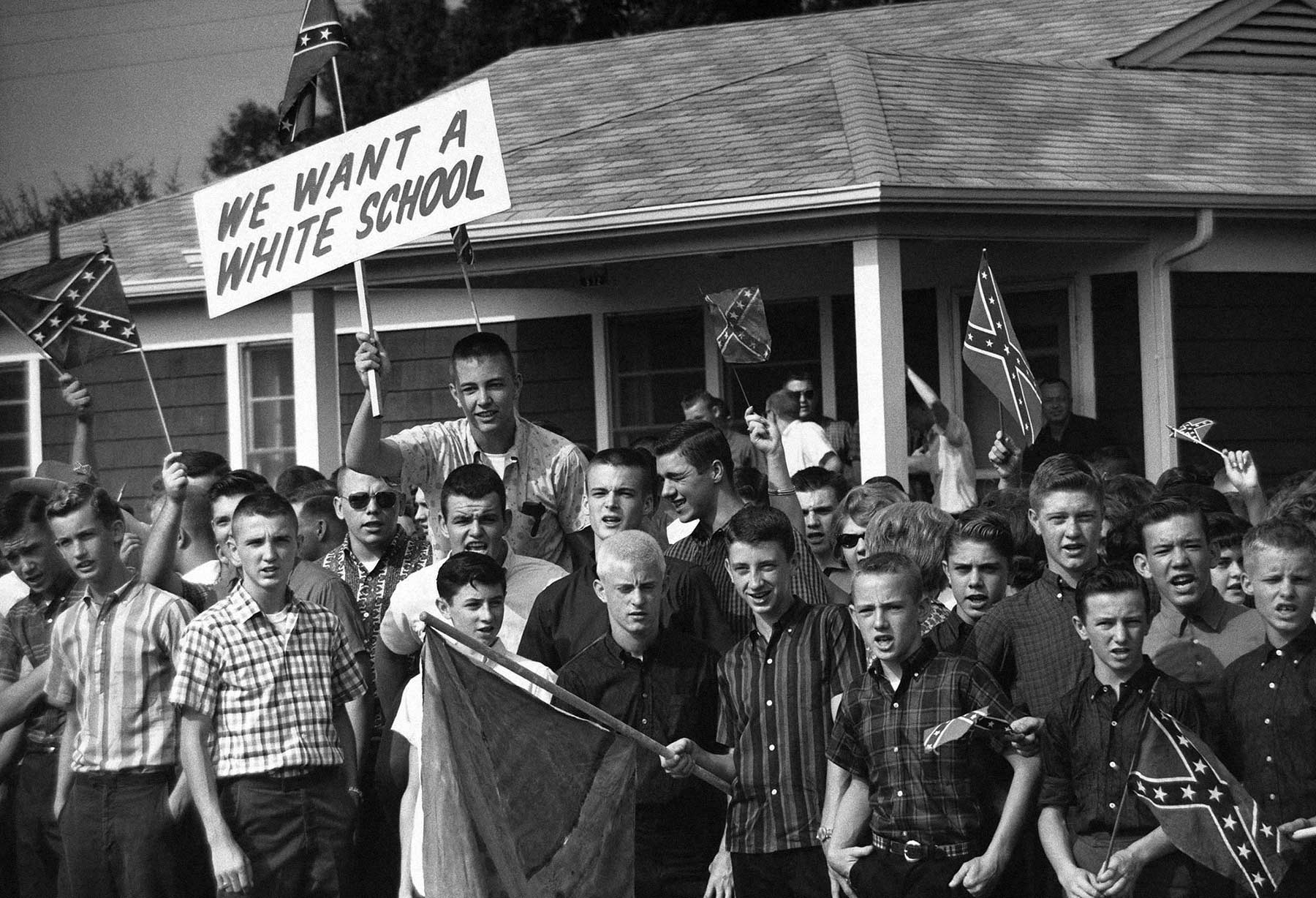
Teenage boys wave Confederate flags during a protest against school integration in Montgomery, Alabama, 1963. (© Flip Schulke/CORBIS/ Getty Images)
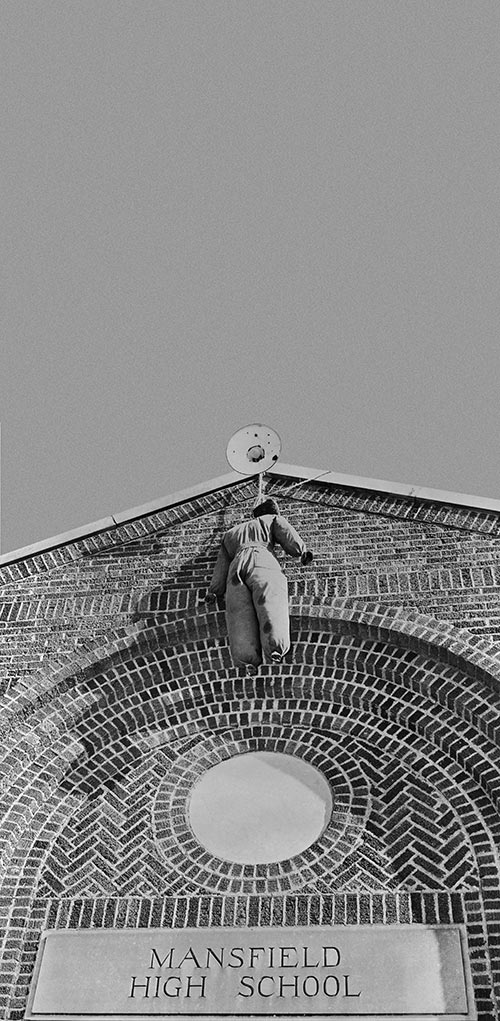 On August 30, 1956, a white mob hung an African American effigy at
the top of Mansfield High School’s flag pole in Texas. The effigy was hung
and burned in response to 12 Black students desegregating the school.
(Bettman/Corbis)
After Brown II, many states authorized the closing of public schools to avoid integration. In 1956, the Virginia General Assembly passed a law that required the closure of any public school where white and Black children were enrolled together
and cut off state funds to integrated schools.
168
Griffin v. Cty. Sch. Bd. of Prince Edward Cty., 377 U.S. 218, 221 (1964).
The governor promptly closed nine schools in Warren County, Charlottesville, and Norfolk to prevent integration.
169
Lewis, Massive Resistance, 53, 56-57.
On August 30, 1956, a white mob hung an African American effigy at
the top of Mansfield High School’s flag pole in Texas. The effigy was hung
and burned in response to 12 Black students desegregating the school.
(Bettman/Corbis)
After Brown II, many states authorized the closing of public schools to avoid integration. In 1956, the Virginia General Assembly passed a law that required the closure of any public school where white and Black children were enrolled together
and cut off state funds to integrated schools.
168
Griffin v. Cty. Sch. Bd. of Prince Edward Cty., 377 U.S. 218, 221 (1964).
The governor promptly closed nine schools in Warren County, Charlottesville, and Norfolk to prevent integration.
169
Lewis, Massive Resistance, 53, 56-57.
States also redirected public funds to maintain segregated education. After Virginia’s highest court invalidated the 1956 laws closing and defunding integrated public schools, lawmakers enacted a new “freedom of choice” program that created
tuition grants for white students to attend new private schools.
170
Griffin, 377 U.S. at 221.
Officials in Prince Edward County, Virginia, closed their entire public school system in May 1959 after a federal court ordered integration and instead created private schools for white students using state grants and county tax credits
to cover tuition expenses.
171
Ibid.; Virginia Historical Society, “The Closing of Prince Edward
County’s Schools,” http://www.vahistorical.org/collections-and
resources/virginia-history-explorer/civil-rights-movement-virginia/
closing-prince.
More than 90 percent of the county’s white students enrolled in the new all-white private school, while the more than 1700 Black students in the county had no state-funded educational option for five years,
172
Benjamin Muse, Virginia’s Massive Resistance (Bloomington: Indiana
University Press, 1961), 151
until the Supreme Court overturned Virginia’s tuition grants and forced Prince Edward County schools to reopen.
173
Griffin, 377 U.S. 218.
Federal courts struck down state efforts to selectively close public schools to avoid integration, 174 James v. Almond, 170 F. Supp. 331, 337 (E.D. Va. 1959). While the State of Virginia, directly or indirectly, maintains and operates a school system with the use of public funds, or participates by arrangement or otherwise in the management of such a school system, no one public school or grade in Virginia may be closed [to avoid integration] while the state permits other public schools or grades to remain open at the expense of the taxpayer but those rulings failed to stop white residents from fleeing public schools. In 1963, after a federal court ordered immediate integration in Macon County, Alabama, Governor George Wallace temporarily closed Tuskegee High School to prevent 13 Black students from enrolling. When the school reopened, all 275 white students withdrew, and most used state-funded scholarships to enroll at Macon Academy — a newly formed, all-white private school. 175 Maggie Martin, “Former Students Look Back 50 Years After Integration of Tuskegee High School,” NPR, September 1, 2003; Montgomery (Ala.) Advertiser, “Macon Academy Scheduled to Begin Classes Monday,” October 1, 1963; Tuskegee (Ala.) News, “Attorney Gray, Judge Johnson Foiled Efforts to Halt Macon Schools Integration,” July 13, 2006; Anne Permaloff and Carl Grafton, Political Power in Alabama (Athens: University of Georgia Press, 1995), 197-98.
In the wake of Brown, up to a quarter of white Southerners admitted to pollsters that they “favored violence, if necessary, to prevent school desegregation.” 176 Michael J. Klarman, Brown v. Board of Education and the Civil Rights Movement (New York: Oxford University Press, 2007), 184. In 1956, Ku Klux Klan rallies drew hundreds, even thousands, in South Carolina, Georgia, Alabama, and Florida — states where the group had been considered extinct. In 1957, six Birmingham, Alabama, Klansmen castrated a Black man after taunting him for “think[ing] nigger kids should go to school with [white] kids.” 177 Klarman, From Jim Crow to Civil Rights, 424; Salem (Or.) Capital Journal, “Six Charged With Mayhem Against Negro,” October 8, 1957.
When in the course of human events it becomes necessary to abolish the Negro race, proper methods should be used. Among them are guns, bow and arrows, slingshots and knives.
White Citizens’ Councils claimed to repudiate violence, but their rhetoric suggested otherwise. A handbill circulated at a large council rally in Montgomery, Alabama, denounced desegregation and declared, “When in the course of human events it becomes necessary to abolish the Negro race, proper methods should be used. Among them are guns, bow and arrows, slingshots and knives.” 178 Klarman, From Jim Crow to Civil Rights, 426; Muncie (Ind.) Star Press, “Walter Winchell in New York: To Uncle Sam from a Nephew,” February 3, 1957.
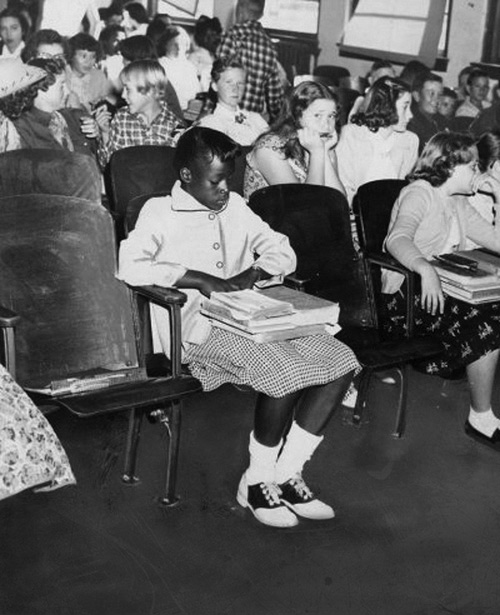 Donna Jean Barksdale, age 11, sits alone on her first day of school
in Hoxie, Arkansas. She was one of 21 children to integrate the school
in 1955. (Mississippi Valley Collection, University of Memphis)
Virtually every year after Brown, school desegregation generated violent opposition somewhere: Milford, Delaware, in 1954;
179
Indiana (Pa.) Gazette, “‘Powder Keg’ In Delaware Segregation,”
September 24, 1954.
Hoxie, Arkansas, in 1955;
180
Tennesseean, “Social Pattern Changing In Schools; 5 Southern States
Geared To Resist,” August 28, 1955.
Tuscaloosa, Alabama,
181
Anniston (Ala.) Star, “Race Incidents Steal News Thunder In 1956,”
December 25, 1956.
Clinton, Tennessee,
182
Talley Morning Star, “Guard Sent To Quell Clinton Riot,” September 2, 1956.
Mansfield, Texas,
183
Hope (Ark.) Star, “Integration in Texas School Brings Near Riot,”
August 31, 1956.
and Clay and Sturgis communities in Kentucky in 1956;
184
Sheboygan (Wis.) Press, “Sturgis (Ky.), The ‘Friendly’ City, Is Racked
By Racial Integration,” September 18, 1956.
Little Rock and Nashville in 1957;
185
Chillicothe (Ohio) Gazette, “Faubus Encouraged Mobs, Ike Charges,”
September 28, 1957; Kansas City (Mo.) Times, “Blast A School: Nashville
Building Is Half Demolished After First Mixing of Classes,” September
10, 1957.
Clinton (again) in 1958;
186
Tennessean, “3 Blasts Rip Classrooms, Walls, Halls,” October 6, 1958.
New Orleans in 1960;
187
7 Montgomery (Ala.) Advertiser, “Police in New Orleans Arrest 93
During Riots,” November 17, 1960.
Athens, Georgia, in 1961;
188
Fort Lauderdale (Fla.) News, “‘Hands Off Georgia U.,’ Court Orders
Governor,” January 10, 1961.
Oxford, Mississippi, in 1962;
189
Greenwood (Miss.) Commonwealth, “Bayonets Protect Meredith As
He Registers; Civilians Attack Troops,” October 1, 1962.
and Birmingham in 1963.
190
Klarman, From Jim Crow to Civil Rights, 421; Santa Fe (N.M.) New
Mexican, “Man Killed In Midnight Riots, 3 Birmingham Schools
Closed,” September 5, 1963.
Donna Jean Barksdale, age 11, sits alone on her first day of school
in Hoxie, Arkansas. She was one of 21 children to integrate the school
in 1955. (Mississippi Valley Collection, University of Memphis)
Virtually every year after Brown, school desegregation generated violent opposition somewhere: Milford, Delaware, in 1954;
179
Indiana (Pa.) Gazette, “‘Powder Keg’ In Delaware Segregation,”
September 24, 1954.
Hoxie, Arkansas, in 1955;
180
Tennesseean, “Social Pattern Changing In Schools; 5 Southern States
Geared To Resist,” August 28, 1955.
Tuscaloosa, Alabama,
181
Anniston (Ala.) Star, “Race Incidents Steal News Thunder In 1956,”
December 25, 1956.
Clinton, Tennessee,
182
Talley Morning Star, “Guard Sent To Quell Clinton Riot,” September 2, 1956.
Mansfield, Texas,
183
Hope (Ark.) Star, “Integration in Texas School Brings Near Riot,”
August 31, 1956.
and Clay and Sturgis communities in Kentucky in 1956;
184
Sheboygan (Wis.) Press, “Sturgis (Ky.), The ‘Friendly’ City, Is Racked
By Racial Integration,” September 18, 1956.
Little Rock and Nashville in 1957;
185
Chillicothe (Ohio) Gazette, “Faubus Encouraged Mobs, Ike Charges,”
September 28, 1957; Kansas City (Mo.) Times, “Blast A School: Nashville
Building Is Half Demolished After First Mixing of Classes,” September
10, 1957.
Clinton (again) in 1958;
186
Tennessean, “3 Blasts Rip Classrooms, Walls, Halls,” October 6, 1958.
New Orleans in 1960;
187
7 Montgomery (Ala.) Advertiser, “Police in New Orleans Arrest 93
During Riots,” November 17, 1960.
Athens, Georgia, in 1961;
188
Fort Lauderdale (Fla.) News, “‘Hands Off Georgia U.,’ Court Orders
Governor,” January 10, 1961.
Oxford, Mississippi, in 1962;
189
Greenwood (Miss.) Commonwealth, “Bayonets Protect Meredith As
He Registers; Civilians Attack Troops,” October 1, 1962.
and Birmingham in 1963.
190
Klarman, From Jim Crow to Civil Rights, 421; Santa Fe (N.M.) New
Mexican, “Man Killed In Midnight Riots, 3 Birmingham Schools
Closed,” September 5, 1963.
In Mansfield, Texas, the local citizens’ council organized white residents armed with guns and other weapons to block Black children from entering school. The mobs also hanged an effigy of a Black man with signs attached to each pant
leg that read, “This Negro tried to enter a white school. This would be a terrible way to die” and “Stay Away, Niggers.” Texas Governor Allan Shivers commended the “orderly protests against a situation instigated and agitated by the [NAACP],”
and sent Texas Rangers to remove any students “white or colored, whose attendance or attempts to attend Mansfield High School would be reasonably calculated to incite violence.”
191
Longview (Tex.) News-Journal, “Shivers Orders Rangers Sent To
Mansfield,” August 31, 1956.
Local residents and state officials prevented Mansfield’s public schools from officially desegregating until 1965.
192
Lewis, Massive Resistance, 79-80.
Mob violence waged by white segregationists throughout the South drew national attention and brought school desegregation to a halt across the region.
In November 1960, after the state legislature’s attempt to block a federal court’s order to desegregate New Orleans schools failed, mobs organized outside two elementary schools where four Black students enrolled. 193 Ibid., 116-17. Escorted by federal marshals, six-year-old Ruby Bridges started first grade at all-white William Frantz Elementary School and was greeted by “hundreds of vicious protestors, their faces contorted by hate, spitting, snarling, and yelling obscenities—such as ‘kill them niggers’—at first-graders walking to school in their Sunday best.” 194 Klarman, Brown v. Board, 183-84.
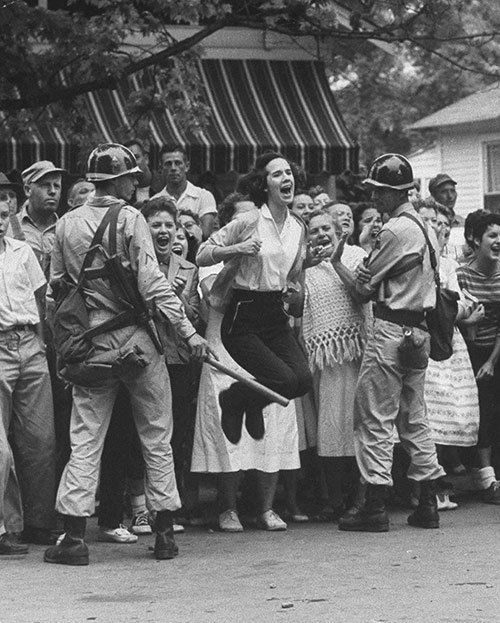 White mothers and children scream at Black children on their
way to school in Sturgis, Kentucky, September 1956. (Photo by Myron
Davis/The LIFE Picture Collection/Getty Images)
A group of white mothers gathered daily to scream invectives at children, using profanity that writer John Steinbeck described as “bestial and filthy and degenerate.”
195
Ibid.
When Ruby arrived in her assigned classroom, she and the teacher were the only two people present; nearly all the white children were withdrawn from school and Ruby remained the only student in her class for the entire school year. Despite
Ruby’s young age, a woman threatened to poison her on the second day of school, and another woman confronted her with a Black doll in a wooden coffin.
196
The Guardian, “Civil Rights Pioneer Laments School Segregation:
‘You almost feel like you’re back in the 60s,’” November 14, 2014
White mothers and children scream at Black children on their
way to school in Sturgis, Kentucky, September 1956. (Photo by Myron
Davis/The LIFE Picture Collection/Getty Images)
A group of white mothers gathered daily to scream invectives at children, using profanity that writer John Steinbeck described as “bestial and filthy and degenerate.”
195
Ibid.
When Ruby arrived in her assigned classroom, she and the teacher were the only two people present; nearly all the white children were withdrawn from school and Ruby remained the only student in her class for the entire school year. Despite
Ruby’s young age, a woman threatened to poison her on the second day of school, and another woman confronted her with a Black doll in a wooden coffin.
196
The Guardian, “Civil Rights Pioneer Laments School Segregation:
‘You almost feel like you’re back in the 60s,’” November 14, 2014
Ruby’s family members also faced threats and retaliation: the local grocery story banned the family from entering, Ruby’s father was fired from his job,
197
“Brown v. Board at Fifty: ‘With an Even Hand,’” Library of Congress
(exhibit, 2004), https://www.loc.gov/exhibits/brown/brown-aftermath.
html.
and her grandparents were evicted from the Mississippi farm where they worked as sharecroppers.
198
Sharon P. Robinson, The Children Hurricane Katrina Left Behind:
Schooling Context, Professional Preparation, and Community Politics (Peter
Lang Inc., 2007), 16.
 Hundreds of white students protest at the University of Mississippi
in Oxford, Mississippi, on September 20, 1962, in response to James
Meredith’s enrollment as the school’s first Black student. (AP)
In 1962, after a federal court ordered the University of Mississippi to enroll 29-year-old Black veteran and Mississippi native James Meredith, Governor and White Citizens’ Council member Ross Barnett personally blocked Mr. Meredith from entering the
Ole Miss campus.
199
Joseph Crespino, In Search of Another Country: Mississippi and the
Conservative Counterrevolution (Princeton: Princeton University Press,
2007), 15; Anthony Lewis, “Mississippi Aides Blamed by U.S. Officials for Riot,” New York Times, October 2, 1962.
On September 30, 1962, pro-segregation mobs gathered on campus and waged violent riots that left two people dead and many injured. When a federal marshal escorted Mr. Meredith on campus to enroll, Mississippi Attorney General Joe
Patterson told students they could refuse “to socialize or fraternize with an undesirable student.” Mr. Meredith suffered ongoing isolation, harassment, and violence.
200
Beckley (W. Va.) Post-Herald, “Not in Contempt, Barnett Contends,”
October 17, 1962.
As he ate in the cafeteria one night in October, a rock was thrown through a window near his table, and on another occasion, a dead raccoon was left on his car.
201
James Meredith, A Mission from God: A Memoir and Challenge for
America (Atria Books, 2012), 163-64.
Hundreds of white students protest at the University of Mississippi
in Oxford, Mississippi, on September 20, 1962, in response to James
Meredith’s enrollment as the school’s first Black student. (AP)
In 1962, after a federal court ordered the University of Mississippi to enroll 29-year-old Black veteran and Mississippi native James Meredith, Governor and White Citizens’ Council member Ross Barnett personally blocked Mr. Meredith from entering the
Ole Miss campus.
199
Joseph Crespino, In Search of Another Country: Mississippi and the
Conservative Counterrevolution (Princeton: Princeton University Press,
2007), 15; Anthony Lewis, “Mississippi Aides Blamed by U.S. Officials for Riot,” New York Times, October 2, 1962.
On September 30, 1962, pro-segregation mobs gathered on campus and waged violent riots that left two people dead and many injured. When a federal marshal escorted Mr. Meredith on campus to enroll, Mississippi Attorney General Joe
Patterson told students they could refuse “to socialize or fraternize with an undesirable student.” Mr. Meredith suffered ongoing isolation, harassment, and violence.
200
Beckley (W. Va.) Post-Herald, “Not in Contempt, Barnett Contends,”
October 17, 1962.
As he ate in the cafeteria one night in October, a rock was thrown through a window near his table, and on another occasion, a dead raccoon was left on his car.
201
James Meredith, A Mission from God: A Memoir and Challenge for
America (Atria Books, 2012), 163-64.
James Meredith persisted and graduated on August 18, 1963, but that did not end his activism or the violence against him. In 1966, while staging a one-man protest march across Mississippi, Mr. Meredith was shot and wounded. 202 Chuck Cook, “Capturing History: Shooting of James Meredith,” Jackson (Miss.) Clarion-Ledger, June 4, 2016.
In 1956, after a federal court ordered the segregated University of Alabama to admit a Black woman named Autherine Lucy, a white mob gathered on campus, burned a cross, and marched through town singing Dixie. Chanting “Hey, hey, ho, ho, Autherine has got to go,” the mobs terrorized any African Americans it encountered, broke car windows, and smashed roofs. 203 Frye Gaillard, Cradle of Freedom: Alabama and the Movement that Changed America (Tuscaloosa: University of Alabama Press, 2004), 40.
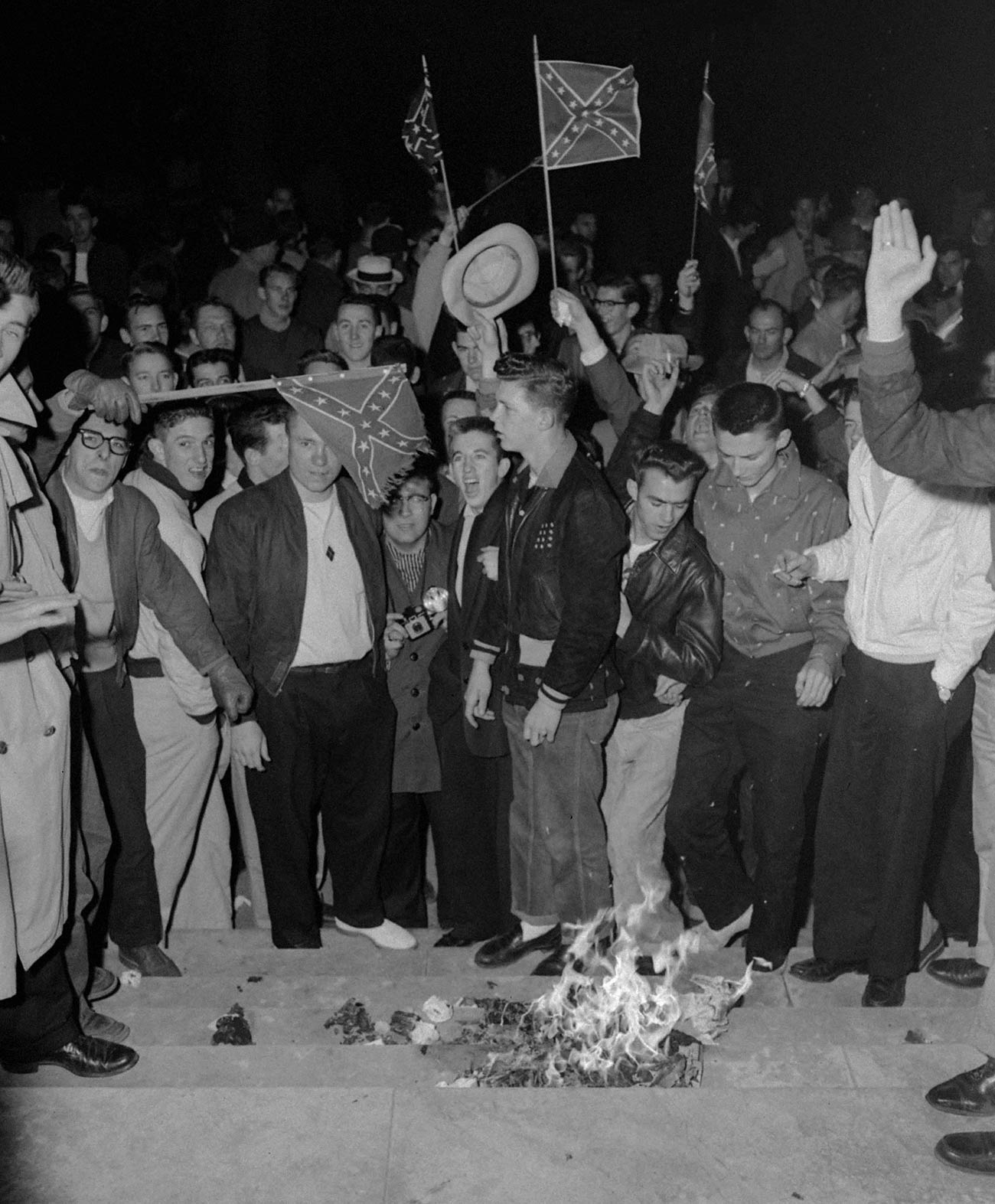
Students at the University of Alabama burn desegregation literature in Tuscaloosa, Alabama, on February 6, 1956, in response to the enrollment of Autherine Lucy. (Library of Congress/AP)
The mob of students and older community members grew to 1200 people and confronted Ms. Lucy on her third day of class, shouting “Lynch the nigger!” and “Keep Bama white!” 204 Ibid., 41; Lewis, Massive Resistance, 78. She was pelted with rotten eggs, gravel, and mud balls containing rocks and had to hide in the back of a police car to escape. 205 Gaillard, Cradle of Freedom, 41. In response, the university suspended Ms. Lucy citing safety concerns, and then expelled her when she tried to challenge the suspension in court. This major segregationist victory spurred a surge of support for the citizens’ councils. 206 Ibid., 42.
Seven years later, in 1963, the University of Alabama was ordered to admit three Black students. 207 Ibid., 166-68 George Wallace had just taken office as governor after promising to resist integration: “I shall refuse to abide by any such illegal federal court order even to the point of standing in the schoolhouse door, if necessary.” 208 Ibid., 163; Bob Ingram, “Wallace Pledges to Fight Mixing in Ala. Schools,” Montgomery (Ala.) Advertiser, March 11, 1962. He famously reaffirmed this promise in his inaugural address, declaring from “where once Jefferson Davis stood”:
In the name of the greatest people that have ever trod this earth I draw the line in the dust and toss the gauntlet before the feet of tyranny . . . and I say . . . segregation now . . . segregation tomorrow . . . segregation forever. 209 George C. Wallace, “Inaugural Address,” January 14, 1963, State Capitol, Montgomery, Alabama, https://web.utk.edu/~mfitzge1/ docs/374/wallace_seg63.pdf.
The federal court enjoined Governor Wallace from interfering in the Black students’ enrollment, but when they arrived to register on June 11, 1963, he stood in the doorway of Foster Auditorium to block their entrance 210 Gaillard, Cradle of Freedom, 168, 171-72. and declared, “I stand here today, as Governor of this sovereign State, and refuse to willingly submit to illegal usurpation of power by the Central Government.” 211 George C. Wallace, Statement and Proclamation, June 11, 1963, http://www.archives.state.al.us/govs_list/schooldoor.html. Only after President John F. Kennedy federalized the national guard did Wallace step aside and allow the students to register. 212 Gaillard, Cradle of Freedom, 172. The national guard remained for several days to prevent violence.
In response to the extensively reported violent chaos in communities fighting desegregation, some states passed laws cutting off state funds to districts that desegregated without conducting a referendum, 213 Klarman, From Jim Crow to Civil Rights, 349 and Southern compliance with Brown went from slow to stopped. Arguing against these postponements in 1958, NAACP attorney Thurgood Marshall noted that courts were delaying integration orders only in response to violence or the threat of violence, and he expressed concern that white children were being taught that violating the law was the way to get what they wanted. “I’m not worried about the Negro kids,” he added. “They’ve been struggling with democracy for years.” 214 Des Moines (Iowa) Register, “High Court Hints It Won’t Delay Integration,” September 12, 1958.
The Black students who arrived for the first day of school faced a white mob that chased them through the streets and beat them with chains, pipes, and clubs so severely that some had to be hospitalized. The mob violence continued for days without intervention from law enforcement. 215 Bruce Hartford, “Grenada Mississippi—Chronology of a Movement” (1967), Civil Rights Movement Veterans, http://www.crmvet.org/info/ grenada.htm
In 1967, 13 years after Brown, a report by the U.S. Commission on Civil Rights observed that “violence against Negroes continues to be a deterrent to school desegregation.” 216 Press release announcing release of Southern school desegregation, 1966-67, United States Commission on Civil Rights, August 8, 1967, https://www.law.umaryland.edu/marshall/usccr/documents/ pressrel67.pdf.